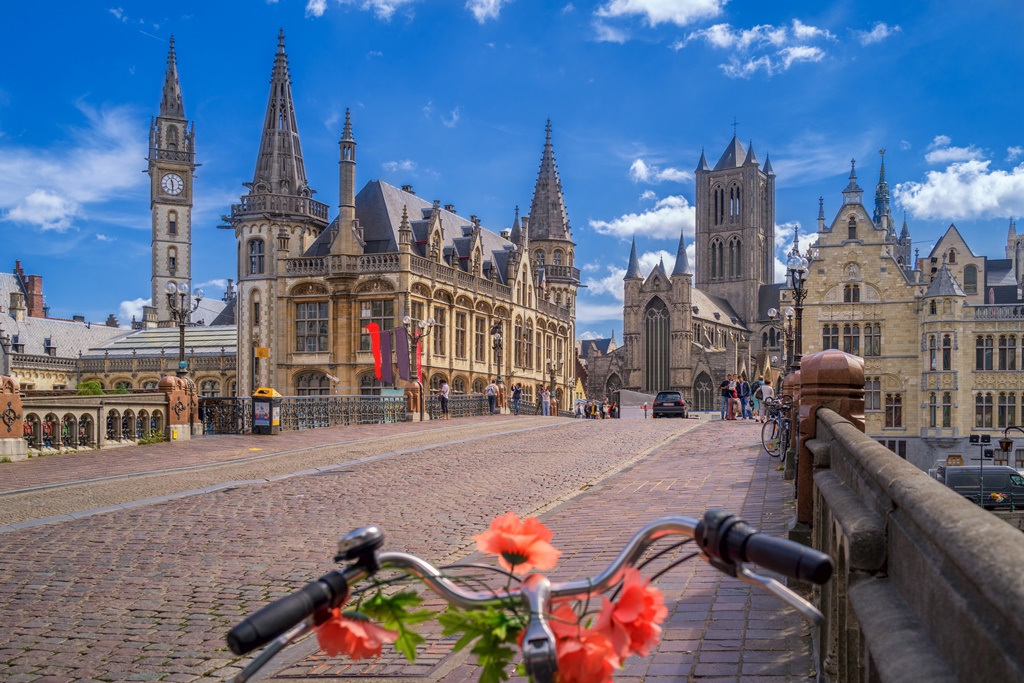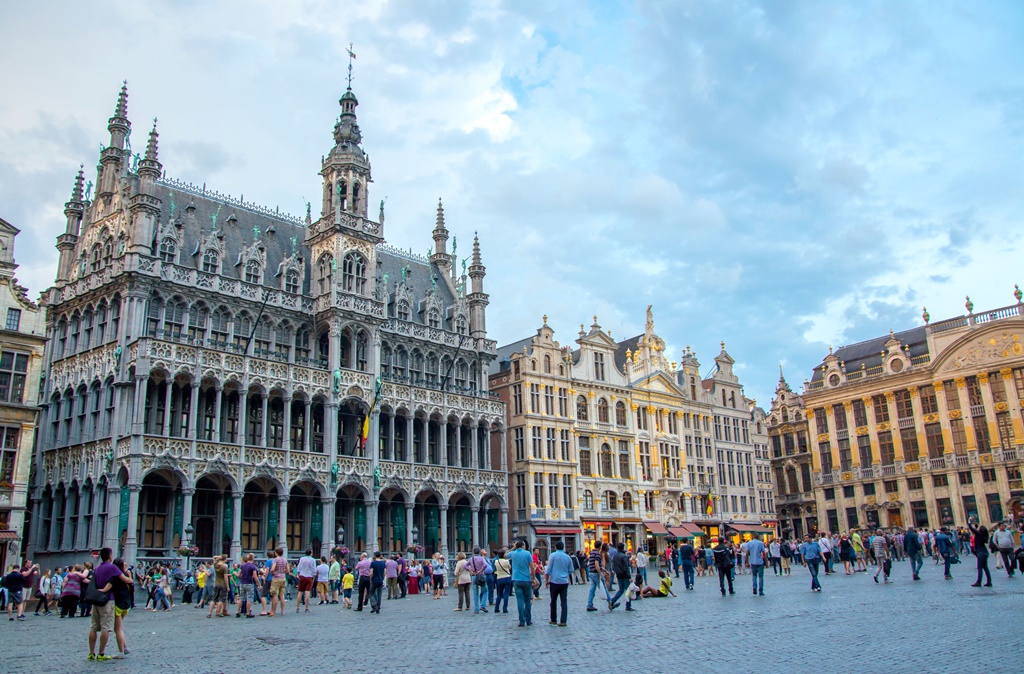Belgium Round Trip
History, food, beer, chocolate – Belgium has it all. However, there is so much more to it than just the capital city of Brussels which is usually the number one destination when people decide to visit this tiny country in Western Europe. All corners of Belgium can be reached within two hours from Brussels – we think we just said enough and it’s time we planned a perfect round trip for you, so you can blend in the culture and discover all breathtaking corners of this cosmopolitan, yet still provincial country!
1) Bruges
Also known as Brugge, it is a charming medieval town often referred to as an ‘open-air’ museum. Why, you might ask? Well, the city centre is a UNESCO cultural heritage site, so start wandering around the streets and embrace the local atmosphere and make sure to visit Jerusalem’s Church as well, dating back to the 15th century and containing a gruesome altarpiece covered in skull motifs. The list does not end here – this lively city also houses the Groeningmuseum with a splendid collection of Flemish Primitives and Renaissance artists and the Choco Story dedicated to Belgian most special treat, chocolate. And if you like bizarre, there is something for you too – Lucifernum, an old temple turned into a home of Willy Retsin, a self-proclaimed vampire, who will let you in once you ring the bell.
Getting to Bruges:
- Bus: You can arrive to Bruges Central Bus Station (Brugge centraal station) from many European cities, e.g. Amsterdam, Lille, Paris, Eindhoven, and many others. Check for your preferred departure city on GetByBus.
2) Ghent
Historic yet oozing a young atmosphere, Ghent is one of Belgium’s top destinations. This vibrant port city is not so touristy, but if you decide to stop there for a break, you will be amazed by the architecture of cathedrals, squares, castles and all the other landmarks which look like a huge historical painting. Once you arrive there, make sure to buy CityCard Ghent – a pass used for all sights, public transport and much more at no extra charge, which cannot be found anywhere else in Europe! Belgium’s huge student hub offers numerous quirky bars, good-yet-not-too-expensive restaurants, but what is an absolute must see is St Bavo’s Cathedral, home to the most stolen artwork in the world – The Adoration of the Mystic Lamb, and the S.M.A.K. Museum with the biggest collection of contemporary art in the country.
Getting from Bruges to Ghent:
- Train: This is the only means of public transport on the route between Bruges and Ghent. The train departs every few minutes and the journey takes approximately 50 minutes. One way ticket is 6.80€.
3) Brussels
As multicultural as a city can get, Brussels is much more than that – historic, modern, majestic, quirky. Belgium’s capital abounds in sights, starting from the Grand Place, which is considered to be one of the world’s most beautiful squares with the surrounding entire medieval city core, Manneken Pis and Atomium, a huge composition of an iron crystal, to the theme park Mini-Europe and Mont des Arts, a beautiful slope-garden, followed up by a generous smattering of prestigious museums and cultural temples (MIM, Magritte Museum, Bozar, Cinematek, etc.). Brussels is also a perfect destination for shopping – and who doesn’t want some of that? There are numerous small boutiques across the city, but the Jeu de Balle Flea Market and antique markets full of various bargains and second-hand goods are also definitely worth visiting (especially Rue de la Paille, Rue des Minimes and Rue de Rollebeek).
Getting from Ghent to Brussels:
- Bus: There are several departures a day from Ghent to Brussels. The journey time is 1h and a one-way ticket costs around 5€.
- Train: Despite departing every few minutes on the aforementioned route, trains are a more expensive and more time consuming option. The trip is 1h 25min long and costs around 9,30€ per direction.
4) Leuven
More than anything else, Leuven is a university town. Its Katholieke Universiteit Leuven is the oldest university in the country, dating back to 1425. The city is home to Belgium’s prettiest and most extravagantly decorated town hall (Stadhuis) and the super-famous Stella Artois beer which originated in 1366. The Oude Markt, a long rectangular square, is a place where you can find 33 bars or restaurants, which is why it has earned the nickname of ‘the longest bar in Europe’. Your next stop should be Leuven’s most beautiful Gothic church, St Peter’s, whose Treasury Room boasts a small, yet rich collection of religious sculptures and paintings, or the town’s leading M-Museum Leuven, which displays both international and Flemish works.
From Brussels to Leuven:
- Train: Trains between Brussels and Leuven depart every few minutes and it takes approximately 40 minutes of travelling. One ticket costs around 5,50€ per direction.
5) Liege
Being the ‘Most Visited City in Wallonia’ (Belgium’s French-speaking region), Liege attracts visitors for its charming and quirky architecture or, as locals know it, joie de vivre. One of the city’s most famous landmarks is the Collegiate Church of St Bartholomew, founded in the 11th century in Mosan style, really unique of Liege and the surrounding area. Your sightseeing does not end here – climb 374 steps with a 30 degree slope of the so-called Mountain of Bueren, known as one of the most extreme stairway in the world. On the first Saturday of October the Night of the Hills creates a really breathtaking display on the ‘mountain’ (it is best to come before 9 p.m.). Do not leave Liege before trying the authentic Liege waffle (not the same as other Belgian waffles!) which contain delicious exploding sugar crystals. Yummy!
Getting from Leuven to Liege:
- Train: Trains on this route depart every 30 minutes. The journey takes about 40 minutes and costs around 11,30€ per direction.
6) Antwerp
Belgium’s second biggest city and capital of ‘cool’, as Belgians describe it, has maintained its medieval heart with lanes filled with cozy cafes and bars, the impressive Cathedral of Our Lady and a riverside fortress. Sophisticated, yet very approachable, the world’s biggest diamond hub (it is estimated that two-thirds of the world’s gem-quality diamonds pass through this Belgian city) successfully combines old and new, so start with the spectacular old town house abandoned for years, Graanmarkt 13, and some of the city’s museums such as the Rubens House and the Red Star Line Museum, but make sure you absolutely try all of the following: mosselen-friet (mussels and fries), waterzooi (chicken or fish casserole), carbonnade Flamande (beef stew with beer), and of course, Belgian waffles (with several toppings!) and delicious chocolate packaged with ribbons.











